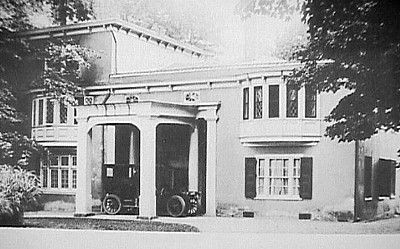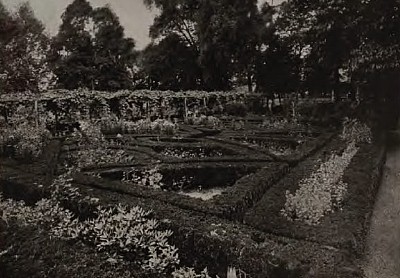| |
Ury House -- 1912
1 March 1912
Col. Jos. U. Crawford of the Pennsylvania R.R. Decorated by the Japanese Emperor

The whole ground floor of the original building is now the dining room. Tremendously thick walls convince the the beholder that they might have successfully withstood the battering of far more formidable engines of assult than were likely to have been used against them. For the sake of greater height and ventilation, the low-raftered ceiling of the dining-room was raised at one of the many stages of alteration, the upper part, of course, being corporated with the rest of the bedrooms on the second floor. The work of the Swedes has been spoken of as a square tower built of stone hard by. According to tradition preserved in print by a neighborhood writer, the
tower consisted of a curious cellar, approach by solid stone steps, leading to a door of wrought iron, supported on either side of tremendous stone drillings. Over the cellar was a square room from which a steep staircase led to another, and over it, with sloping roofs, and reached by a very rickety ladder, was a garret.
In the cellar was also a great fireplace with a contrivance evidently designed for melting lead and moulding bullets.
At each successive of the upward and outward growth since Colonial days, the original lines have become more and more obliterated, so that from the outside it is well-nigh impossible to distinguish one portion from another and assign to each its proper period, especially as the whole building has been stoccoed and the colour freshened now and again. It is very nearly as difficult inside as it is outside to tell which is which, because of the changes dictated on various occasions by the exigencies of the owners. These many alterations have given a refreshing irregularity, and upstairs the inequality of levels keeps one constantly on the lookout to avoid going on his nose as he dodges around unexpected corners and takes first one step up and then perhaps two down, threading his way through perplexing passages. The entrance, under a square-pillared portico, through a wide doorway into a low-ceilinged hall, marks the meeting point of the oldest portion of the house with the eighteenth-century addition to the west.
Immediately around the house venerable shade trees spread their branches, while the approach from the road is through a long straight avenue of lofty pines, planted more than a century ago. Southeast of the house and sheltered by it from the sweep of the northwest winds, is the garden, enclosed by a high, thick box hedge. A box-edged walk shaded by a grape-covered trellis runs the entire length of the garden from east to west and divides it into equal sections. The northern half is laid out in geometrically shaped flower beds, bordered with box and separated by narrow gravel paths. The box is so old and so luxuriant, and has grown so far beyond its original limits, that the flower garden might more fitingly be called the box garden. Looking in from outside, the labyrinth of squares, circles, and intersecting diagonals seems almost a solid expance of glossy green studded with patches of gay-coloured bloom. Only tall flowers like phlox and larkspurs and hollyhocks can lift their heads high enough to show to advantage, but for the pleasure of such glorious box one is willing to forego many flowers which, after all, they can have elsewhere. The boxwood of Ury was a source of just pride to its owners in Colonial times, and a century and a half of growth has not lessened the esteem in which it is helf. South of the trellised walk is the kitchen garden divided into plots by borders of box.

Beyond the garden, and a little way down a gentle slope, is the barn, a great stone structure with ample room to hold all the crops of the hundred or more acres of farmland belonging to Ury. It is said that in old times the barn was connected with the cellar of the house by a secret vaulted stone passage. What appears to have been a doorway in the cellar wall has been blocked up with masonry for many years, and the present generation can say nothing with certainty about the existence of the passage. The doorway may simply have led into a cave for roots or a wine cellar, such as are frequently to be found in the subterranean regions of old houses and which imaginative people are prone to believe the beginning of secret tunnels. The story goes, however, that there really is a passage and that, when it was last opened, there was found in it the skeleton of a man, presumably one of the soldiers imprisoned in the barn at one time during the Revolutionary War, and either thrust in there with foul intent ot else overcome by death while trying to escape from his captors.
Harold Donaldson Eberlein and Horace Mather Lippincott, The Colonial Homes of Philadelphia and Its Neighborhoods (1912), pp. 314-16.
They recalled with pleasure the gay entertaining at Ury 33 years ago [1912] when they were presented to society as "Assembly debutantes" by their parents, the late Capt. Joseph U. Crawford and Mrs. Crawford, the former Harriet Henriques.
Capt. Crawford, who had enlisted with the Washington Grays, 17th Pennsylvania Volunteer Infantry, at the opening of the Civil War, became interested in railroad engineering at the close of the conflict. He built the first railroad in Northern Japan. Before his death he had become one of the top engineers of the Pennsy.
Rex Rittenhouse, "Ury House Guest Was Victim Of Jittery Maid" (Philadelphia: The Evening Bulletin, 1945.10.21).
|